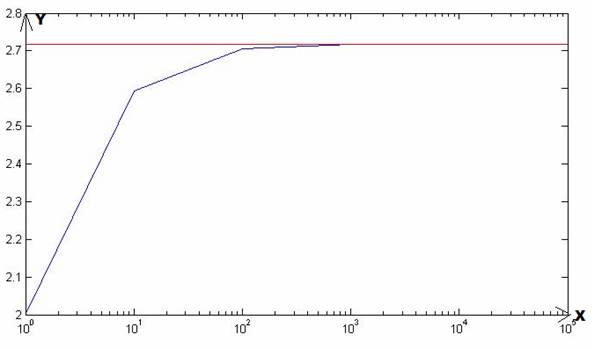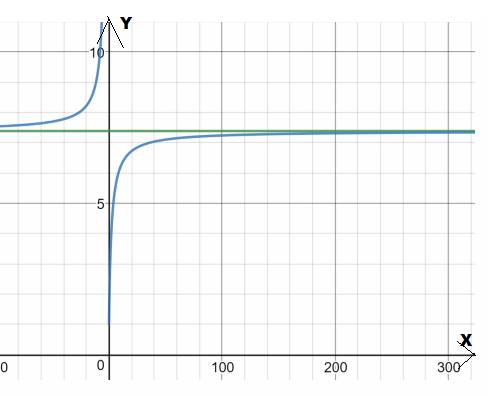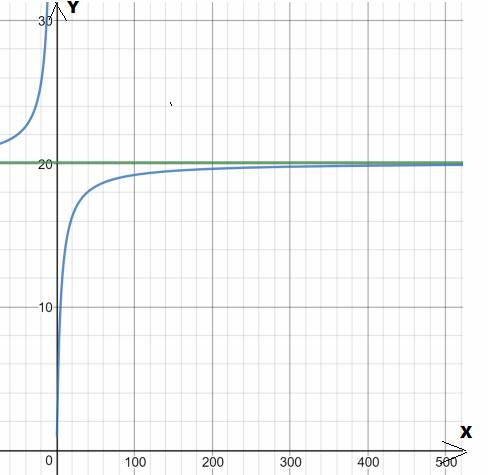
(a)
To prove : The statement is
(a)
Explanation of Solution
Given information:
The statement is
Calculation:
And the table is:
| 1 | 2 |
| 10 | 2.5937 |
| 100 | 2.7048 |
| 1000 | 2.7169 |
| 10000 | 2.7181 |
| 100000 | 2.7183 |
The graph is shown below:

Therefore, the required given statement
(b)
To prove: The given statement.
(b)
Explanation of Solution
Given information:
The statement is
Calculation:
If
Then ,
Input,
| 10 | 6.1917 |
| 100 | 7.2446 |
| 1,000 | 7.3743 |
| 10,000 | 7.3876 |
| 100,000 | 7.389 |
| 7.3891 | |
| 7.3891 |
The graph is shown below:

If
Then ,
Input
| 10 | 13.786 |
| 100 | 19.219 |
| 1,000 | 19.996 |
| 10,000 | 20.077 |
| 100,000 | 20.085 |
| 20.086 | |
| 20.086 |
The graph is shown below:

Therefore, , the required given statement
(c)
To explain: The given statement.
(c)
Answer to Problem 56E
which is the formula for interest compounded continuously.
Explanation of Solution
Given information:
The idea of interest compounded continuously results from the compounding of interest over ever-shorter time periods.
Calculation:
The compound interest value is
Compounding interest over smaller and smaller periods means nn gets larger and larger. From part
So,
which is the formula for interest compounded continuously.
Chapter 6 Solutions
Advanced Placement Calculus Graphical Numerical Algebraic Sixth Edition High School Binding Copyright 2020
- I circled the correct, could you explain using stokearrow_forwardUse Euler's method to numerically integrate dy dx -2x+12x² - 20x +8.5 from x=0 to x=4 with a step size of 0.5. The initial condition at x=0 is y=1. Recall that the exact solution is given by y = -0.5x+4x³- 10x² + 8.5x+1arrow_forwardFind an equation of the line tangent to the graph of f(x) = (5x-9)(x+4) at (2,6).arrow_forward
- Find the point on the graph of the given function at which the slope of the tangent line is the given slope. 2 f(x)=8x²+4x-7; slope of the tangent line = -3arrow_forwardUse the product rule to find the derivative of the following. p(y) (y¹ + y²) (6y¯³-10y¯4)arrow_forwardplease dont use chat gptarrow_forward
- Find this expression in frequency domain in a expression y(t), in time, that is.arrow_forwardplease dont use chat gptarrow_forwardQuestion Given the graph of f(z) below, find the graph of the derivative of f(z). Select the correct answer below: ° 7-6-5-4-3 123 ° ° 2 -7-6-5-4-3- 123 -° 2-4 -°- °- -7-6-5-4-3-2-1 1 5 +arrow_forward
 Calculus: Early TranscendentalsCalculusISBN:9781285741550Author:James StewartPublisher:Cengage Learning
Calculus: Early TranscendentalsCalculusISBN:9781285741550Author:James StewartPublisher:Cengage Learning Thomas' Calculus (14th Edition)CalculusISBN:9780134438986Author:Joel R. Hass, Christopher E. Heil, Maurice D. WeirPublisher:PEARSON
Thomas' Calculus (14th Edition)CalculusISBN:9780134438986Author:Joel R. Hass, Christopher E. Heil, Maurice D. WeirPublisher:PEARSON Calculus: Early Transcendentals (3rd Edition)CalculusISBN:9780134763644Author:William L. Briggs, Lyle Cochran, Bernard Gillett, Eric SchulzPublisher:PEARSON
Calculus: Early Transcendentals (3rd Edition)CalculusISBN:9780134763644Author:William L. Briggs, Lyle Cochran, Bernard Gillett, Eric SchulzPublisher:PEARSON Calculus: Early TranscendentalsCalculusISBN:9781319050740Author:Jon Rogawski, Colin Adams, Robert FranzosaPublisher:W. H. Freeman
Calculus: Early TranscendentalsCalculusISBN:9781319050740Author:Jon Rogawski, Colin Adams, Robert FranzosaPublisher:W. H. Freeman
 Calculus: Early Transcendental FunctionsCalculusISBN:9781337552516Author:Ron Larson, Bruce H. EdwardsPublisher:Cengage Learning
Calculus: Early Transcendental FunctionsCalculusISBN:9781337552516Author:Ron Larson, Bruce H. EdwardsPublisher:Cengage Learning





